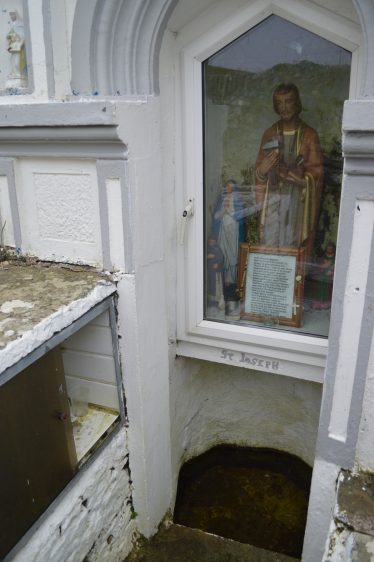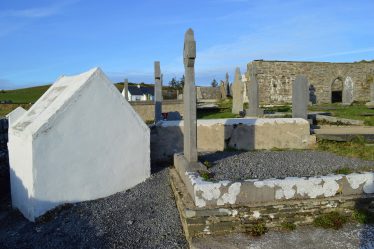Saint Josephs Well, also known as Toberlaghteen Tober Laichtín, Kilfarboy






Townland: Kilfarboy, Kilfarboy Parish
Description of Holy Well and Landscape Setting
This holy well stands close to the perimeter wall in the far left corner of Kilfarboy Graveyard. It is in a small well-house containing a statue of Saint Joseph with several smaller statues sharing a glassed enclosure above the well. There are three short steps leading down to the water. On either side of the main shrine are two small recesses containing statues of the Madonna and Child. There are some votive offerings of rosary beads, medals and little statues present. The well area is excellently maintained.
Saint and Feast Day Associated with Holy Well
Saint Joseph’s feast day is 19th March. The well is also known as Tober Laichtín, Saint Laichtín’s Well. Unfortunately for the original local Saint Laichtín, his feast day also falls on 19th March. Joseph’s veneration now totally eclipses that of the original saint associated with the well, Laichtín.
Natural Heritage around the Holy Well
The well lies at the edge of a cemetery. There is no natural foliage in the immediate area. The source of the water for the well appears to be a spring feeding up from below ground.
Heritage Attractions Nearby
Miltown Malbay, Quilty and Spanish Point Villages are a 10-15 minute drive south. Here are restaurants, shops, beaches and fine views of the Atlantic.
Additional Information
Ordnance Survey Letters by John O’Donovan and Eugene Curry, 1839:
‘Saint Lachtainn, whose festival is still observed in the Parish on the 19th day of March the same as in Achadh-Uir in Ossory, and whose well is situated within the Churchyard and still much frequented by devotees and invalids on Sundays and Thursdays’.
James Frost, ‘The History and Topography of the County of Clare’, 1893
‘A holy well, dedicated to St. Lachtain, is found in the churchyard. Stations are there regularly performed on the 19th of March. As to the tradition of the neighbourhood, that ascribes the name to the fact of certain yellow men, Spaniards of the Armada, being buried there, it is simple nonsense. It was known as Cill Feabrath centuries before the Spanish Armada existed’.
Discover More…
Ordnance Survey Letters, Royal Irish Academy
Ordnance Survey Letters, Ask About Ireland
Frost, J 1893, The History and Topography of the County of Clare: From the Earliest Times to the Beginning of the 18th Century, Sealy, Bryers & Walker, Dublin
– Part I. Topography of Thomond Chapter 9. Ui Fearmaic; Gleann Omra; Ui Bracain; Ui Floinn; Ui Ronghaile.
Record of Monuments and Places Number
RMP-CL031-00803




No Comments
Add a comment about this page